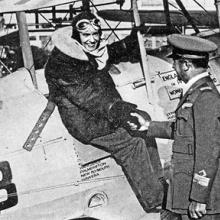Jean Batten
-
Jean Batten grew up in New Zealand and developed a love for aviation that overcame her desire to be a concert pianist. Her interest in flying stemmed from the 1919 England to Australia flight by Ross and Keith Smith, and later solo flights.
Batten's father did not approve of her aviation enthusiasm but she convinced her mother to move to England with her and help her become a pilot. She received her license and her commercial rating at the London Aeroplane Club at Stag Lane and then began planning for a flight from England to Australia. Her first two attempts failed, but she succeeded in 1934, flying a Gipsy Moth.
Batten became an instant sensation in Australia, New Zealand, and in England upon her return flight the next year (it was the first round trip by a woman). In 1935, she broke James Mollison's records for England to Brazil and Dakar to Natal while becoming the first woman to solo across the South Atlantic. Then, in 1936, she realized her dream of flying solo from England to New Zealand in a Percival Gull in 11 days and earned her second consecutive Harmon Trophy, having shared the first one in 1935 with Amelia Earhart. In 1937 she set another record for an Australia to England flight. Unable to obtain a flying job during World War II, Batten gave up flying and eventually became a recluse, living with her mother in Majorca, Spain and appearing in public only for a few anniversary events. In 1937, she published her autobiography, My Life.

